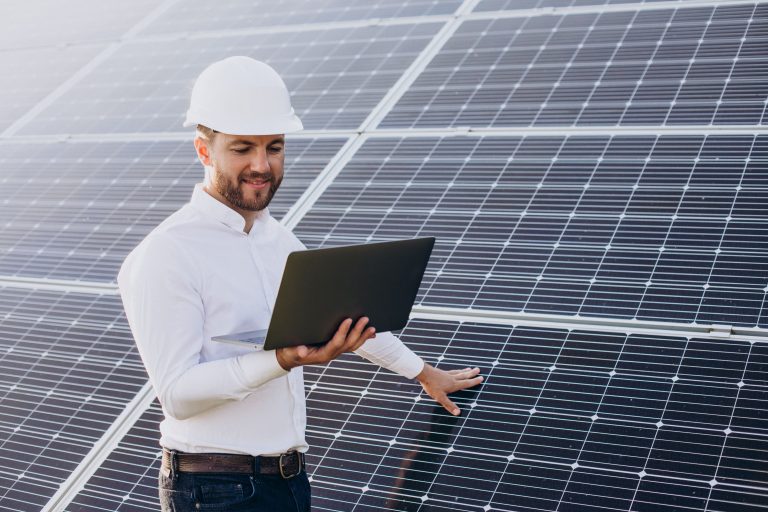In recent years ,there have been rapid advancements for a cleaner and sustainable energy solution in the solar energy industry.They are driven by the growing global demand for clean, sustainable power solutions. As the world transitions to renewable energy, advancements in solar technology have not only improved efficiency but also made solar power more affordable and accessible. From cutting-edge materials like perovskite and quantum dot solar cells to innovative approaches such as floating solar farms and solar-powered hydrogen production.Here are the key emerging technologies, innovations, and trends:
1. Perovskite Solar Cells
- What’s new: Perovskite solar cells (PSCs) offer higher energy conversion rates and are cheaper to produce compared to traditional silicon-based cells and are more efficient and commercially viable.
- Advances: Recent innovations focus on increasing their durability and scaling up production while maintaining cost efficiency.
2. Bifacial Solar Panels
- What’s new: Bifacial solar panels boost energy production by up to 30% and capture sunlight on both sides.
- Trend: These panels are increasingly used in large-scale solar farms and commercial installations for enhanced energy output.
3. Floating Solar Farms (Floatovoltaics)
- What’s new: Solar panels installed on bodies of water, such as lakes and reservoirs, are gaining momentum due to the reduced land usage and enhanced efficiency due to the cooling effect of water.
- Trend: Countries with limited land for solar farms, like Japan and Singapore, are leading in the deployment of floating solar farms.
4. Agro Voltaics (Agriculture and Solar Integration)
- What’s new: Agro voltaics optimize land use by allowing crops to grow beneath solar panels by combining solar energy production with agriculture.
- Trend: This dual-use approach is popular in Europe and North America, addressing land scarcity and promoting sustainability in food production.
5. Solar Energy Storage Solutions
- What’s new:,Innovations like solid-state batteries and lithium-iron phosphate (LFP) batteries provides safer, more efficient energy storage options as battery storage technology is evolving.
- Trend: Integrating solar with storage systems allows for round-the-clock energy availability, reducing reliance on the grid.
6. Solar-Powered EV Charging Stations
- What’s new: The growing electric vehicle (EV) market is driving demand for solar-powered EV charging infrastructure.
- Trend: Solar charging stations, both standalone and grid-connected, are emerging as a key feature in urban planning, fostering green transportation.
7. Solar-Powered Hydrogen Production
- What’s new: Innovations in solar-driven electrolysis are enhancing the production of green hydrogen, a clean fuel made from water and solar energy.
- Trend: Green hydrogen is gaining attention as a viable solution for decarbonizing sectors like transportation and heavy industry.
8. Building-Integrated Photovoltaics (BIPV)
- What’s new: Solar panels are being integrated directly into building materials, like roofs, windows, and facades, reducing the aesthetic and functional barriers to solar adoption in urban areas.
- Trend: This trend is popular in Europe and Asia, where sustainability regulations are driving the development of energy-efficient buildings.
9. Advanced Solar Tracking Systems
- What’s new: Solar tracking technology is evolving with AI and machine learning, which enables panels to follow the sun more accurately and boost energy generation.
- Trend: The use of single-axis and dual-axis tracking systems in solar farms is growing, improving efficiency and reducing costs.
10. Recycling and Sustainability Innovations
- What’s new: With solar panel installations surging, recycling technology is being developed to reclaim valuable materials like silicon, silver, and copper from end-of-life panels.
- Trend: Regulations in Europe and the U.S. are pushing for sustainable disposal and recycling of solar panels to ensure long-term industry sustainability.
11. Quantum Dot Solar Cells
- What’s new: Quantum dot technology is making solar cells more efficient at harvesting light, especially in low-light conditions.
- Trend: This innovation is expected to enhance solar adoption in regions with variable sunlight, such as northern climates.
12. Artificial Intelligence and Machine Learning
- What’s new: AI is increasingly used to optimize solar panel performance, predict maintenance needs, and maximize energy output.
- Trend: AI-driven energy management systems are helping utilities and businesses integrate solar energy with smart grids more efficiently.
Conclusion:
These emerging technologies and trends reshape the solar energy landscape, making it more efficient, affordable, and widely accessible as the world transitions to clean energy sources. This evolution is positioning solar power as a key player in the global energy mix, fostering a greener and more resilient future.






